List of National Historic Sites of Canada in New Brunswick
This is a list of National Historic Sites of Canada (French: Lieux historiques nationaux du Canada) in the province of New Brunswick. There are 62 National Historic Sites designated in New Brunswick, 8 of which are administered by Parks Canada (identified below by the beaver icon ![]() ).[1][2] The first National Historic Sites to be designated in New Brunswick were Fort Beauséjour – Fort Cumberland and Fort Gaspareaux in 1920.
).[1][2] The first National Historic Sites to be designated in New Brunswick were Fort Beauséjour – Fort Cumberland and Fort Gaspareaux in 1920.
This list uses names designated by the Historic Sites and Monuments Board of Canada, which may differ from other names for these sites.
National Historic Sites
| Site[1] | Date(s) | Designated | Location | Description | Image |
|---|---|---|---|---|---|
| 1 Chipman Hill[3][4] | 1854 (c.) (completed) | 1984 | Saint John 45°16′26.66″N 66°3′47.43″W / 45.2740722°N 66.0631750°W |
Symbolic of upper-middle class urban housing in Saint John during the mid-19th century; features a variety of decorative trompe-l'œil wall and ceiling murals | |
| Arts Building[5] | 1827 (completed) | 1951 | Fredericton 45°56′53.93″N 66°38′28.65″W / 45.9483139°N 66.6412917°W |
A classically inspired masonry structure at the University of New Brunswick; the oldest university building in Canada still in continuous use | |
| Augustine Mound[6] | 500 (c.) BCE (established) | 1975 | Metepenagiag Mi'kmaq Nation 46°55′48.37″N 65°49′20.06″W / 46.9301028°N 65.8222389°W |
A circular ritual site surrounding a burial mound; a sacred site representative of Mi'kmaq spirituality, exhibiting Adena burial rituals | |
| Beaubears Island Shipbuilding |
1790 (established) | 2001 | Miramichi 46°58′18.34″N 65°34′17.96″W / 46.9717611°N 65.5716556°W |
A 24-hectare (59-acre) site featuring the remains of an early 19th-century shipyard | |
| Belmont House / R. Wilmot Home[8] | 1820 (completed) | 1975 | Lincoln 45°54′49.39″N 66°35′14.05″W / 45.9137194°N 66.5872361°W |
A large neoclassical country house associated with Robert Duncan Wilmot, a Father of Confederation | |
| Boishébert |
1756 (camp established) | 1930 | Miramichi 46°58′11.17″N 65°34′42.99″W / 46.9697694°N 65.5786083°W |
The site of a camp on Beaubears Island where Acadians, under the leadership of Charles Deschamps de Boishébert, sought refuge from 1756 to 1760 during the Expulsion of the Acadians | |
| Carleton Martello Tower |
1815 (completed) | 1930 | Saint John 45°15′7.53″N 66°4′33.54″W / 45.2520917°N 66.0759833°W |
A martello tower located across the harbour from downtown Saint John, built to protect the city from an American land attack during the War of 1812; representative of the type of coastal defence used by the British during the Napoleonic era |  |
| Chandler House / Rocklyn[11] | 1831 (completed) | 1971 | Dorchester 45°53′54.78″N 64°30′54.56″W / 45.8985500°N 64.5151556°W |
A Classical Revival-style house associated with Edward Barron Chandler, a Father of Confederation | |
| Charlotte County Court House[12] | 1840 (completed) | 1981 | St. Andrews 45°4′32.47″N 67°2′57.26″W / 45.0756861°N 67.0492389°W |
A simple wood-frame courthouse with a pedimented portico; the best preserved example in New Brunswick of the typical mid-19th century Maritime courthouse | 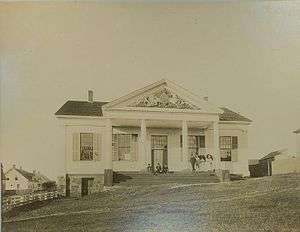 |
| Christ Church Anglican[13] | 1856 (completed) | 1990 | Maugerville 45°52′17.08″N 66°26′46.72″W / 45.8714111°N 66.4463111°W |
A wooden church illustrative of the eccclesiological phase of Gothic Revival architecture in Canada | |
| Christ Church Cathedral[14] | 1853 (completed) | 1981 | Fredericton 45°57′27″N 66°38′5.86″W / 45.95750°N 66.6349611°W |
A cathedral whose spire is a landmark in the historic centre of Fredericton; one of the best examples of ecclesiological Gothic Revival architecture in Canada, and one which established an architectural pattern followed in the design of many churches in 19th-century Canada | .jpg) |
| Connell House[15] | 1840 (completed) | 1975 | Woodstock 46°9′3.96″N 67°34′30.36″W / 46.1511000°N 67.5751000°W |
A Greek Revival wooden mansion distinguished by a double-height columned verandah; in the early 19th century, large homes inspired by classical temples were common in the United States, but comparatively rare in Canada | |
| Denys Fort / Habitation[16] | 1600s (c.) (established) | 1952 | Shippagan 47°52′52.75″N 64°35′22.02″W / 47.8813194°N 64.5894500°W |
Archaeological remains of a 17th-century French trading post | |
| Fort Beauséjour – Fort Cumberland |
1751 (established) | 1920 | Aulac 45°51′52.49″N 64°17′29.62″W / 45.8645806°N 64.2915611°W |
A star-shaped fort that defended French interests in the Chignecto isthmus; after its capture by the British in 1755, the fort repulsed an attack by American revolutionary sympathizers in 1776, which contributed to keeping Nova Scotia in the British Empire |  |
| Fort Charnisay[18] | 1645 (established) | 1923 | Saint John 45°15′46.04″N 66°4′32.63″W / 45.2627889°N 66.0757306°W |
The site of a succession of military forts between 1645 and 1775 due to its strategic position on the western edge of the city’s harbour and overlooking the Saint John River; today the site is marked by a cairn and a boulder |  |
| Fort Gaspareaux |
1751 (established) | 1920 | Port Elgin 46°2′34.4″N 64°4′14.7″W / 46.042889°N 64.070750°W |
An archaeological site containing traces of a French fort; symbolic of the struggle between France and Britain for North America in the 1750s | 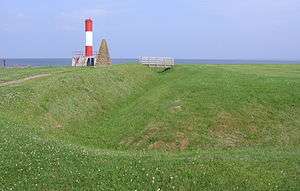 |
| Fort Howe[20] | 1777 (established) | 1966 | Saint John 45°16′36″N 66°04′23″W / 45.27667°N 66.07306°W |
The partial reconstruction of a fort that guarded Saint John from the American Revolutionary War through to the War of 1812; the fort's designation as a National Historic Park in 1914 marked the beginning of Canada's emerging system of National Historic Sites |  |
| Fort Jemseg[21] | 1659 (established) | 1927 | Jemseg 45°46′6.72″N 66°7′56.01″W / 45.7685333°N 66.1322250°W |
Site of an English trading post, captured by the Dutch in 1674 | |
| Fort La Tour[22] | 1631 (established) | 1923 | Saint John 45°16′21.76″N 66°4′20.18″W / 45.2727111°N 66.0722722°W |
An archaeological site containing the remains of a 17th-century fortified fur-trading post established by Charles de Saint-Étienne de la Tour; one of the earliest centres of the French fur trade with the Aboriginal peoples in the region | 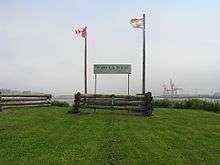 |
| Fort Nashwaak (Naxoat)[23] | 1691 (established) | 1924 | Fredericton 45°57′40.87″N 66°37′36.07″W / 45.9613528°N 66.6266861°W |
The site of a French fort that had once sat at the mouth of the Nashwaak River where it meets the Saint John River; the base of many raids against New England, one of which resulted in the Siege of Pemaquid in 1696 | 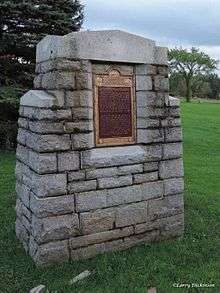 |
| Fort Nerepis[24] | 1659 (fort established) | 1930 | Grand Bay–Westfield 45°22′12″N 66°14′3.12″W / 45.37000°N 66.2342000°W |
A cairn marking the approximate site of a fortified Maliseet stronghold, and then a small French fort, at the confluence of the Nerepis River and Saint John River; the remains of the fortifications and their precise locations have never been found | 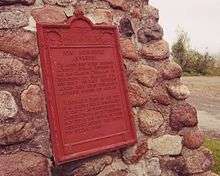 |
| Fredericton City Hall[25] | 1876 (completed) | 1984 | Fredericton 45°57′48.87″N 66°38′35.29″W / 45.9635750°N 66.6431361°W |
A three-storey, Second Empire style town hall; the oldest municipal hall in Atlantic Canada still used for civic administration | 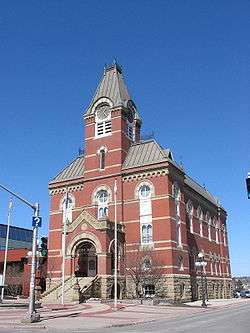 |
| Fredericton Military Compound[26][27] | 1784 (established) | 1960 | Fredericton 45°57′45.58″N 66°38′26.64″W / 45.9626611°N 66.6407333°W |
An important grouping of British colonial-era military buildings, which has served as premises for both military and government institutions for over 200 years |  |
| Free Meeting House[28] | 1821 (completed) | 1990 | Moncton 46°5′38.59″N 64°46′26.52″W / 46.0940528°N 64.7740333°W |
A simple wood-frame meeting house that, as the only local place of worship at the time, was used by all denominations; a symbol of religious tolerance in the Maritimes |  |
| Greenock Church[29] | 1824 (completed) | 1994 | St. Andrews 45°4′36.8″N 67°3′13.18″W / 45.076889°N 67.0536611°W |
A church noteworthy for its role in the development of Presbyterianism in New Brunswick; an excellent example of the Palladian style in Canadian church architecture |  |
| Gibson Family Plot[30] | c. 1913 (begun) | 2010 | Fredericton 45°59′12″N 66°35′39″W / 45.98667°N 66.59417°W |
Headstones of Alexander "Boss" Gibson, his wife and their family members, totaling 27 stones, arranged in a circle. The central stones are intricately carved from white granite. | |
| Hammond House[31] | 1889 (completed) | 1990 | Sackville 45°53′58.65″N 64°22′37.16″W / 45.8996250°N 64.3769889°W |
A house built for artist John A. Hammond and now located on the campus of Mount Allison University; an excellent example of the Queen Anne Revival Style in Canadian domestic architecture | |
| Hartland Covered Bridge[32] | 1921 (completed) | 1980 | Hartland 46°17′47.77″N 67°31′50.65″W / 46.2966028°N 67.5307361°W |
A wooden covered bridge crossing the Saint John River; the longest existing covered bridge in the world |  |
| Imperial / Bi-Capitol Theatre[33] | 1913 (completed) | 1985 | Saint John 45°16′21.82″N 66°3′27.82″W / 45.2727278°N 66.0577278°W |
An early 20th-century theatre facing onto King's Square; a nationally significant example of a theatre built specifically for live performances | |
| La Coupe Dry Dock |
1700s (c.) (established) | 1933 | Aulac 45°51′48.94″N 64°16′29.41″W / 45.8635944°N 64.2748361°W |
Site may represent 18th-century Acadian construction | |
| Loyalist House[35] | 1817 (completed) | 1958 | Saint John 45°16′28.42″N 66°3′40.51″W / 45.2745611°N 66.0612528°W |
An excellent example of New England-style Federal architecture, and representative of the houses built by prosperous United Empire Loyalists; one of the oldest residences in the city and a survivor of the Great Fire, the house was maintained by five generations of the same family until 1959 | |
| Marine Hospital[36] | 1831 (completed) | 1989 | Miramichi 47°1′20.07″N 65°30′37.22″W / 47.0222417°N 65.5103389°W |
A sandstone building with a domed cupola, overlooking the Miramichi River; the oldest surviving marine hospital in Canada | |
| Marysville Cotton Mill[37] | 1885 (completed) | 1986 | Fredericton 45°58′41.65″N 66°35′19.69″W / 45.9782361°N 66.5888028°W |
A four-storey, red-brick cotton mill building with a central tower; representative of the brick pier mills that were common in the Canadian textile industry | |
| Marysville Historic District[38] | 1840 (c.) (established) | 1993 | Fredericton 45°58′44.01″N 66°35′17.44″W / 45.9788917°N 66.5881778°W |
A former industrial community on the banks of the Nashwaak River; a rare surviving example of a 19th-century, single-industry company town with both its plant and company housing intact | |
| McAdam Railway Station (Canadian Pacific)[39] | 1901 (completed) | 1976 | McAdam 45°35′20.4″N 67°19′48″W / 45.589000°N 67.33000°W |
A stone, Chateau-style railway station and hotel; associated with the period of the rapid growth of the Canadian Pacific Railway and a rare surviving example of a combined station and hotel | 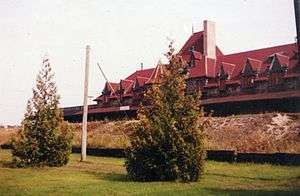 |
| Meductic Indian Village / Fort Meductic[40] | 1600s (c.) | 1924 | Meductic 45°35′20.4″N 67°19′48″W / 45.589000°N 67.33000°W |
The principal settlement of the Maliseet in the 17th century, and an important fur trading centre; the construction of the Mactaquac Dam in 1968 flooded the site, and the cairn marking the site was moved to nearby Fort Meductic Road | 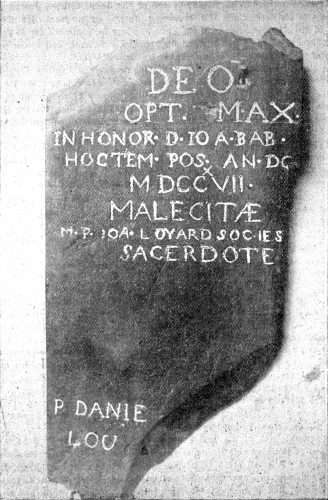 |
| Minister's Island[41] | 1889 (estate established) | 1996 | St. Andrews 45°35′20.4″N 67°19′48″W / 45.589000°N 67.33000°W |
The picturesque summer estate and gentleman’s farm of William Cornelius Van Horne on a 280-hectare (690-acre) island in Passamaquoddy Bay |  |
| Minister's Island Pre-contact Sites[42] | 1000 (c.) BCE (established) | 1978 | St. Andrews 45°35′20.4″N 67°19′48″W / 45.589000°N 67.33000°W |
Archaeological sites containing the remains of four houses and a shell midden originating from a coastal winter settlement | |
| Miscou Island Lighthouse[43] | 1856 (completed) | 1974 | Miscou Island 48°0′32.4″N 64°29′27.6″W / 48.009000°N 64.491000°W |
One of the few remaining wooden, octagonal, tapered lighthouses in Canada; among the oldest in the Gulf of Saint Lawrence region |  |
| Monument Lefebvre |
1856 (completed) | 1994 | Memramcook 45°58′45.8″N 64°33′59.98″W / 45.979389°N 64.5666611°W |
Built in memory of Camille Lefebvre, who founded the first French language institution to confer university degrees in Atlantic Canada; now serves as an Acadian cultural centre |  |
| Number 2 Mechanics' Volunteer Company Engine House[45] | 1841 (completed) | 1995 | Saint John 45°16′24.56″N 66°3′24.61″W / 45.2734889°N 66.0568361°W |
The oldest remaining fire hall in Canada built to house hand-operated pumper fire engines; symbolic of the early phase in fire fighting in Canada when volunteer fire companies were the primary line of defence against fires in Victorian-era cities | 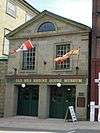 |
| Old Government House[46] | 1828 (completed) | 1958 | Fredericton 45°57′56.52″N 66°39′21.36″W / 45.9657000°N 66.6559333°W |
The stone Palladian-style official residence of the Lieutenant Governor; the location of a historic 1866 meeting between Governor Arthur Gordon and Premier Albert James Smith which paved the way for the colony's entry into Confederation | .gif) |
| Ordnance Building[47] | 1842 (built) | 2015 | St. John 45°15′55″N 66°03′15″W / 45.265366°N 66.054256°W |
Rare colonial-era military ordnance building, it survived the Great Fire of 1877 | |
| Oxbow[48] | 1000 BCE (c.) (community established) | 1982 | Metepenagiag Mi'kmaq Nation 46°56′19.6″N 65°48′40.18″W / 46.938778°N 65.8111611°W |
A site where stratified archaeological resources are buried in the silts and gravels of the Little Southwest Miramichi River bank; a unique cultural record of a 3000-year Mi’kmaq community | |
| Partridge Island Quarantine Station[49] | 1830 (established) | 1974 | Saint John 45°14′21.2″N 66°3′11.8″W / 45.239222°N 66.053278°W |
One of two major quarantine stations in Canada in the 19th century, established to protect the citizenry from contagious diseases carried by passengers and crews of in-coming ships |  |
| Prince William Streetscape[50] | 1877 (construction after Great Fire) | 1981 | Saint John 45°16′16.95″N 66°3′42.59″W / 45.2713750°N 66.0618306°W |
A concentration of architecturally notable late 19th-century public and commercial buildings within a two-block area | |
| Rothesay Railway Station (European and North American)[51] | 1860 (completed) | 1976 | Rothesay 45°23′21.8″N 65°59′57.07″W / 45.389389°N 65.9991861°W |
A railway station with stationmaster's quarters on the second storey; commemorates the development of railways in the Maritimes and is a good surviving example of a number two standard station designed by the European and North American Railway |  |
| Saint John City Market[52] | 1876 (completed) | 1986 | Saint John 45°16′26.11″N 66°3′35.69″W / 45.2739194°N 66.0599139°W |
A rare and notable surviving example of a 19th-century market building |  |
| Saint John County Court House[53] | 1829 (completed) | 1974 | Saint John 45°16′25.35″N 66°3′24.65″W / 45.2737083°N 66.0568472°W |
A neoclassical court house typical of early-19th-century, British public buildings in Canada; representative of the judicial system in the province | |
| Seal Cove Smoked Herring Stands[54] | 1870 (established) | 1995 | Grand Manan Island 44°39′6.76″N 66°50′20.66″W / 44.6518778°N 66.8390722°W |
54 wooden buildings surrounding a cove bounded by breakwaters; a cultural landscape once typical of the Maritimes, but increasingly rare today, and evocative of the Atlantic herring fishery |  |
| St. Andrews Blockhouse |
1813 (completed) | 1962 | St Andrews 45°4′37.51″N 67°3′42.81″W / 45.0770861°N 67.0618917°W |
One of the few surviving Canadian examples of a War of 1812 blockhouse; built by the citizens of St. Andrews to protect the town from American raiders |  |
| St. Andrews Historic District[56] | 1783 (town founded) | 1962 | St Andrews 45°4′23.37″N 67°2′50.56″W / 45.0731583°N 67.0473778°W |
A grid of sixty blocks comprising the original part of the present town; a fine example of a town in Canada that still reflects an 18th-century British colonial town plan |  |
| St. Anne's Chapel of Ease[57] | 1847 (completed) | 1989 | Fredericton 45°57′40.01″N 66°38′54.36″W / 45.9611139°N 66.6484333°W |
A small Gothic Revival stone church reflective of the influence of the principles of the Cambridge Camden Society in Canada |  |
| St. John's Anglican Church / Stone Church[58] | 1826 (completed) | 1989 | Saint John 45°16′34.1″N 66°3′41.67″W / 45.276139°N 66.0615750°W |
An early Anglican church; one of the earliest examples of this first phase of the Gothic Revival style in Canada, known as Romantic Gothic Revival | |
| St. Luke's Anglican Church[59] | 1833 (completed) | 1994 | Quispamsis 45°26′38.19″N 65°59′17.33″W / 45.4439417°N 65.9881472°W |
A wooden church that represents one of the best examples of an Anglican church in Canada that reflects the architectural traditions of James Gibbs and Christopher Wren | |
| St. Paul's United Church[60] | 1886 (completed) | 1990 | Fredericton 45°57′35.5″N 66°38′43.38″W / 45.959861°N 66.6453833°W |
A former Presbyterian, now United, church; it is an excellent example of the High Victorian Gothic Revival style in Canada | |
| St. Stephen Post Office[61] | 1887 (completed) | 1983 | St. Stephen 45°11′33.05″N 67°16′37.67″W / 45.1925139°N 67.2771306°W |
A Romanesque Revival building constructed for the local post office, customs offices and internal revenue offices, and having served as the town hall since 1965, it is a fine example of the small urban post offices designed by Thomas Fuller | |
| Tilley House[62] | 1810 (completed) | 1965 | Gagetown 45°46′57.77″N 66°8′36.03″W / 45.7827139°N 66.1433417°W |
A clapboard house that was the birthplace and boyhood home of Sir Samuel Leonard Tilley, a Father of Confederation | |
| Tonge's Island[63] | 1678 (established as capital) | 1925 | Sackville 45°51′11.18″N 64°16′39.97″W / 45.8531056°N 64.2777694°W |
A settlement established in 1676 by Michel Leneuf de la Vallière, which served as the capital of Acadia from 1678 to 1684 | 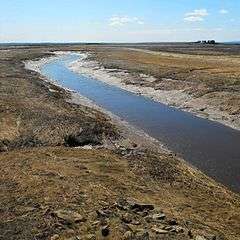 |
| Trinity Church and Rectory[64] | 1789 (completed) | 1977 | Kingston 45°30′9.45″N 65°58′32.8″W / 45.5026250°N 65.975778°W |
The oldest surviving Anglican church in New Brunswick and a rare Maritimes example of a church and rectory surviving as a unit |  |
| William Brydone Jack Observatory[65] | 1851 (completed) | 1954 | Fredericton 45°56′53.03″N 66°38′26.53″W / 45.9480639°N 66.6407028°W |
A wooden, octagonal tower that was the first astronomical observatory in Canada | |
| Wolastoq[66] (Saint John River) | 2011 | Section of the Saint John River between Edmundston and the Bay of Fundy 45°16′0″N 66°4′0″W / 45.26667°N 66.06667°W |
A river that played an important role in 10,000 years of Maliseet history and 400 years of European settlement |  | |
| York County Court House[67] | 1858 (completed) | 1980 | Fredericton 45°57′39.58″N 66°38′14.82″W / 45.9609944°N 66.6374500°W |
The earliest surviving New Brunswick court house constructed of brick | |
See also
| Wikimedia Commons has media related to National Historic Sites of Canada in New Brunswick. |
- History of New Brunswick
- List of historic places in New Brunswick
- Heritage Conservation Act (New Brunswick)
References
- 1 2 Directory of Designations of National Historic Significance of Canada - New Brunswick, Parks Canada
- ↑ New Brunswick, National Historic Sites of Canada - administered by Parks Canada
- ↑ 1 Chipman Hill. Canadian Register of Historic Places. Retrieved 8 February 2012.
- ↑ "1 Chipman Hill National Historic Site of Canada". Directory of Designations of National Historic Significance of Canada. Parks Canada. Retrieved 9 February 2012.
- ↑ Arts Building. Canadian Register of Historic Places. Retrieved 8 February 2012.
- ↑ Augustine Mound. Canadian Register of Historic Places. Retrieved 9 February 2012.
- ↑ Beaubears Island Shipbuilding. Canadian Register of Historic Places. Retrieved 9 February 2012.
- ↑ Belmont House / R. Wilmot Home. Canadian Register of Historic Places. Retrieved 9 February 2012.
- ↑ Boishébert. Canadian Register of Historic Places. Retrieved 9 February 2012.
- ↑ Carleton Martello Tower. Canadian Register of Historic Places. Retrieved 11 February 2012.
- ↑ Chandler House / Rocklyn. Canadian Register of Historic Places. Retrieved 11 February 2012.
- ↑ Charlotte County Court House. Canadian Register of Historic Places. Retrieved 11 February 2012.
- ↑ Christ Church Anglican. Canadian Register of Historic Places. Retrieved 16 February 2012.
- ↑ Christ Church Cathedral. Canadian Register of Historic Places. Retrieved 16 February 2012.
- ↑ Connell House. Canadian Register of Historic Places. Retrieved 18 February 2012.
- ↑ "Denys Fort / Habitation National Historic Site of Canada". Directory of Designations of National Historic Significance of Canada. Parks Canada. Retrieved 18 February 2012.
- ↑ Fort Beauséjour – Fort Cumberland. Canadian Register of Historic Places. Retrieved 18 February 2012.
- ↑ Fort Charnisay. Canadian Register of Historic Places. Retrieved 18 February 2012.
- ↑ Fort Gaspareaux. Canadian Register of Historic Places. Retrieved 18 February 2012.
- ↑ Fort Howe. Canadian Register of Historic Places. Retrieved 19 February 2012.
- ↑ "Fort Jemseg National Historic Site of Canada". Directory of Designations of National Historic Significance of Canada. Parks Canada. Retrieved 19 February 2012.
- ↑ Fort La Tour. Canadian Register of Historic Places. Retrieved 19 February 2012.
- ↑ Fort Nashwaak (Naxoat). Canadian Register of Historic Places. Retrieved 19 February 2012.
- ↑ Fort Nerepis. Canadian Register of Historic Places. Retrieved 19 February 2012.
- ↑ Fredericton City Hall. Canadian Register of Historic Places. Retrieved 19 February 2012.
- ↑ Fredericton Military Compound. Canadian Register of Historic Places. Retrieved 19 February 2012.
- ↑ "Fredericton Military Compound National Historic Site of Canada". Directory of Designations of National Historic Significance of Canada. Parks Canada. Retrieved 19 February 2012.
- ↑ Free Meeting House. Canadian Register of Historic Places. Retrieved 20 February 2012.
- ↑ Greenock Church. Canadian Register of Historic Places. Retrieved 20 February 2012.
- ↑ Gibson Family Plot. Canadian Register of Historic Places. Retrieved 9 June February 2015.
- ↑ Hammond House. Canadian Register of Historic Places. Retrieved 20 February 2012.
- ↑ Hartland Covered Bridge. Canadian Register of Historic Places. Retrieved 20 February 2012.
- ↑ Imperial / Bi-Capitol Theatre. Canadian Register of Historic Places. Retrieved 20 February 2012.
- ↑ "La Coupe Dry Dock National Historic Site of Canada". Directory of Designations of National Historic Significance of Canada. Parks Canada. Retrieved 20 February 2012.
- ↑ Loyalist House. Canadian Register of Historic Places. Retrieved 20 February 2012.
- ↑ Marine Hospital. Canadian Register of Historic Places. Retrieved 20 February 2012.
- ↑ Marysville Cotton Mill. Canadian Register of Historic Places. Retrieved 20 February 2012.
- ↑ Marysville Historic District. Canadian Register of Historic Places. Retrieved 20 February 2012.
- ↑ McAdam Railway Station (Canadian Pacific). Canadian Register of Historic Places. Retrieved 20 February 2012.
- ↑ Meductic Indian Village / Fort Meductic. Canadian Register of Historic Places. Retrieved 22 February 2012.
- ↑ Minister's Island. Canadian Register of Historic Places. Retrieved 22 February 2012.
- ↑ Minister's Island Pre-contact Sites. Canadian Register of Historic Places. Retrieved 22 February 2012.
- ↑ Miscou Island Lighthouse. Canadian Register of Historic Places. Retrieved 25 February 2012.
- ↑ Monument Lefebvre. Canadian Register of Historic Places. Retrieved 25 February 2012.
- ↑ Number 2 Mechanics' Volunteer Company Engine House. Canadian Register of Historic Places. Retrieved 26 February 2012.
- ↑ Old Government House. Canadian Register of Historic Places. Retrieved 26 February 2012.
- ↑ Harper Government Recognizes the Ordnance Building in Saint John, New Brunswick as a National Historic Site, Parks Canada news release, July 21, 2015
- ↑ Oxbow. Canadian Register of Historic Places. Retrieved 26 February 2012.
- ↑ Partridge Island Quarantine Station. Canadian Register of Historic Places. Retrieved 26 February 2012.
- ↑ Prince William Streetscape. Canadian Register of Historic Places. Retrieved 26 February 2012.
- ↑ Rothesay Railway Station (European and North American). Canadian Register of Historic Places. Retrieved 26 February 2012.
- ↑ Saint John City Market. Canadian Register of Historic Places. Retrieved 26 February 2012.
- ↑ Saint John County Court House. Canadian Register of Historic Places. Retrieved 3 March 2012.
- ↑ Seal Cove Smoked Herring Stands. Canadian Register of Historic Places. Retrieved 1 March 2012.
- ↑ St. Andrews Blockhouse. Canadian Register of Historic Places. Retrieved 1 March 2012.
- ↑ St. Andrews Historic District. Canadian Register of Historic Places. Retrieved 1 March 2012.
- ↑ St. Anne's Chapel of Ease. Canadian Register of Historic Places. Retrieved 1 March 2012.
- ↑ St. John's Anglican Church / Stone Church. Canadian Register of Historic Places. Retrieved 3 March 2012.
- ↑ St. Luke's Anglican Church. Canadian Register of Historic Places. Retrieved 3 March 2012.
- ↑ St. Paul's United Church. Canadian Register of Historic Places. Retrieved 3 March 2012.
- ↑ St. Stephen Post Office. Canadian Register of Historic Places. Retrieved 3 March 2012.
- ↑ Tilley House. Canadian Register of Historic Places. Retrieved 3 March 2012.
- ↑ Tonge's Island. Canadian Register of Historic Places. Retrieved 3 March 2012.
- ↑ Trinity Church and Rectory. Canadian Register of Historic Places. Retrieved 3 March 2012.
- ↑ William Brydone Jack Observatory. Canadian Register of Historic Places. Retrieved 3 March 2012.
- ↑ Wolastoq. Directory of Federal Heritage Designations. Parks Canada. Retrieved 3 May 2012.
- ↑ York County Court House. Canadian Register of Historic Places. Retrieved 3 March 2012.
This article is issued from Wikipedia - version of the 11/15/2016. The text is available under the Creative Commons Attribution/Share Alike but additional terms may apply for the media files.